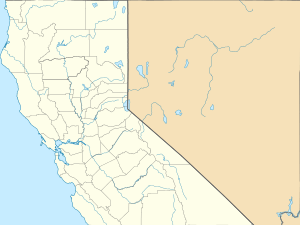Rattlesnake Fire
| Rattlesnake Fire | |
|---|---|
|
Memorial crosses at the site of the 1953 Rattlesnake Fire | |
| Location | Grindstone Canyon, Mendocino National Forest, California |
| Coordinates | 39°39′19″N 122°38′10″W / 39.65528°N 122.63611°W |
| Statistics | |
| Date(s) | July 9, 1953 – July 1, 1953 |
| Burned area | 1,300 acres (530 ha) |
| Cause | Arson |
| Fatalities | 15 |
| Perpetrator(s) | Stan Pattan |
| Map | |
 | |
The Rattlesnake Fire was a wildfire started by an arsonist on July 9, 1953, in Grindstone Canyon on the Mendocino National Forest in northern California. The wildfire killed one Forest Service employee and fourteen volunteer firefighters from the New Tribes Mission, and burned over 1,300 acres (530 ha) before it was controlled on July 11, 1953. It became and is to this day a well-known firefighting textbook case.
Events
The arsonist, Stan Pattan, started two fires, one on private land and the other along Alder Springs Road inside the national forest boundary. He was later convicted and sentenced on two counts of arson.[1] The first fire was quickly suppressed by the Forest Service. The second fire continued burning toward Grindstone Canyon. The fire was spotted and reported mid-afternoon; by evening, it was considered under control. At about 9 pm, though, as detailed in John Maclean's book Fire and Ashes, the wind caused a spot fire north of the road from a burning brand. The plan to bulldoze lines above this fire were not completed as the terrain was too steep for the equipment. Then the wind died down and the spot fire became inactive. With the new weather conditions, a firebreak line was successfully built directly around the inactive spot fire. The wind came up again and changed direction, which started several spot fires west of the crew. All but one of these new fires were extinguished. The men then rested, ate supper, and were in an area out of sight of the fire front, unaware that a flare-up was occurring until too late.[2]
Casualties
Of the 24 firefighters, 15 were burned to death as they tried to outrun the fire through the dense chaparral brush on very steep terrain.
Lessons learned
As a consequence of the fire, there were major changes to wildland fire training, firefighting safety standards, and overall awareness of how weather affects fire behavior.[3][4] The 1953 Rattlesnake Fire prompted U.S. Forest Service Region 5 (Pacific Southwest Region) to increasingly rely on technical strategies such as use of helicopters and airtankers.[5]
Footnotes
References
- Cermak, Robert W, Fire in the Forest—A History of Forest Fire Control on the National Forests in California 1898-1956 USFS Publisher, 2005
- Maclean, John N. The Arsonist, the Watch, and the Rattlesnake Fire, 1953, from Fire and Ashes: On the Front Lines of American Wildfire, Henry Holt and Co. 2003
External links
- Time Magazine article (Monday, Jul. 20, 1953 issue) (Paywall)
- Rattlesnake Fire Memorial & Interpretive Site (with photos)
- Wildfire News coverage of the 2005 Memorial (with photo)
